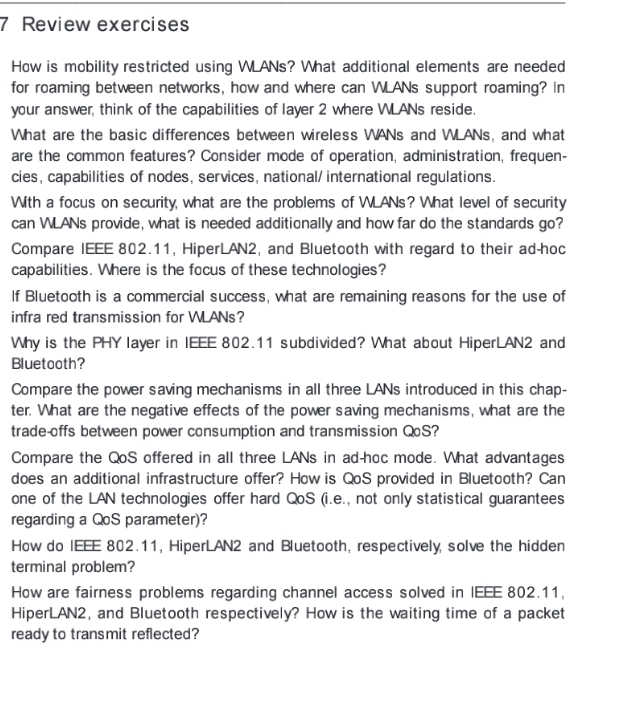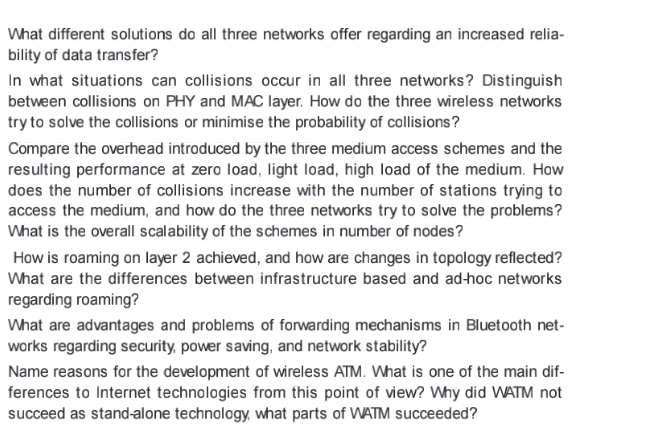Answered step by step
Verified Expert Solution
Question
1 Approved Answer
please answer all questions clearly explaining How is mobility restricted using WLANs? What additional elements are needed for roaming between networks, how and where can


please answer all questions clearly explaining
How is mobility restricted using WLANs? What additional elements are needed for roaming between networks, how and where can WLANs support roaming? In your answer, think of the capabilities of layer 2 where WLANs reside. What are the basic differences between wireless WANs and WLANs, and what are the common features? Consider mode of operation, administration, frequencies, capabilities of nodes, services, national/ international regulations. With a focus on security, what are the problems of WLANs? What level of security can WLANs provide, what is needed additionally and how far do the standards go? Compare IEEE 802.11, HiperLAN2, and Bluetooth with regard to their ad-hoc capabilities. Where is the focus of these technologies? If Bluetooth is a commercial success, what are remaining reasons for the use of infra red transmission for WLANs? Why is the PHY layer in IEEE 802.11 subdivided? What about HiperLAN2 and Bluetooth? Compare the power saving mechanisms in all three LANs introduced in this chapter. What are the negative effects of the power saving mechanisms, what are the trade-offs between power consumption and transmission QoS? Compare the QoS offered in all three LANs in ad-hoc mode. What advantages does an additional infrastructure offer? How is QoS provided in Bluetooth? Can one of the LAN technologies offer hard QoS (i.e., not only statistical guarantees regarding a QoS parameter)? How do IEEE 802.11, HiperLAN2 and Bluetooth, respectively, solve the hidden terminal problem? How are fairness problems regarding channel access solved in IEEE 802.11, HiperLAN2, and Bluetooth respectively? How is the waiting time of a packet ready to transmit reflected? What different solutions do all three networks offer regarding an increased reliability of data transfer? In what situations can collisions occur in all three networks? Distinguish between collisions on PHY and MAC layer. How do the three wireless networks try to solve the collisions or minimise the probability of collisions? Compare the overhead introduced by the three medium access schemes and the resulting performance at zero load, light load, high load of the medium. How does the number of collisions increase with the number of stations trying to access the medium, and how do the three networks try to solve the problems? What is the overall scalability of the schemes in number of nodes? How is roaming on layer 2 achieved, and how are changes in topology reflected? What are the differences between infrastructure based and ad-hoc networks regarding roaming? What are advantages and problems of forwarding mechanisms in Bluetooth networks regarding security, power saving, and network stability? Name reasons for the development of wireless ATM. What is one of the main differences to Internet technologies from this point of view? Why did WATM not succeed as stand-alone technology, what parts of WATM succeededStep by Step Solution
There are 3 Steps involved in it
Step: 1

Get Instant Access to Expert-Tailored Solutions
See step-by-step solutions with expert insights and AI powered tools for academic success
Step: 2

Step: 3

Ace Your Homework with AI
Get the answers you need in no time with our AI-driven, step-by-step assistance
Get Started


